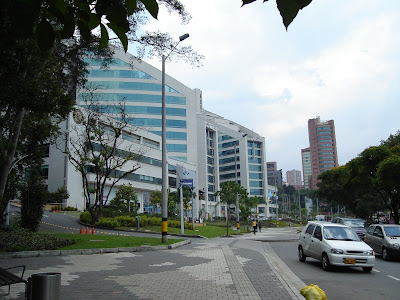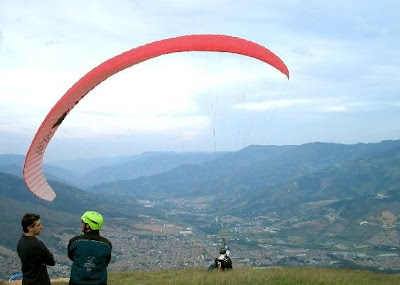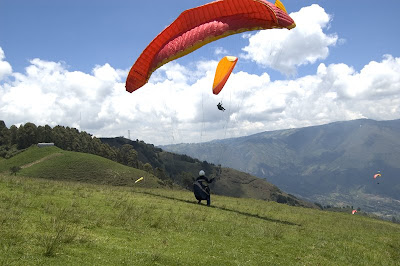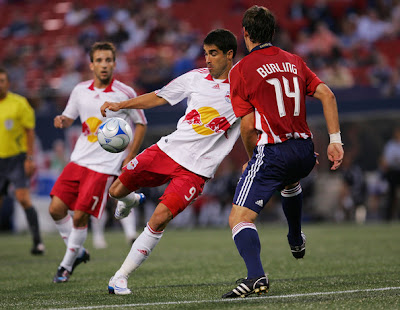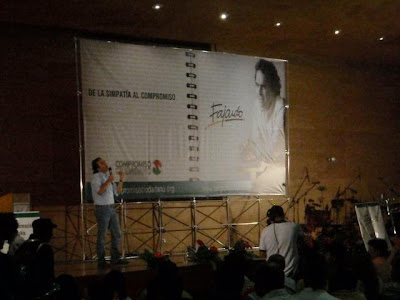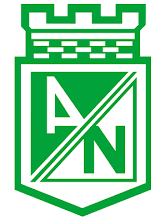 Luis Soriano, a teacher from La Gloria, Colombia, traveled to the village of El Brasil with his Biblioburro on Oct. 11. The donkeys are named Alfa and Beto
Luis Soriano, a teacher from La Gloria, Colombia, traveled to the village of El Brasil with his Biblioburro on Oct. 11. The donkeys are named Alfa and BetoLA GLORIA, Colombia — In a ritual repeated nearly every weekend for the past decade here in Colombia’s war-weary Caribbean hinterland, Luis Soriano gathered his two donkeys, Alfa and Beto, in front of his home on a recent Saturday afternoon.
Sweating already under the unforgiving sun, he strapped pouches with the word “Biblioburro” painted in blue letters to the donkeys’ backs and loaded them with an eclectic cargo of books destined for people living in the small villages beyond.
His choices included “Anaconda,” the animal fable by the Uruguayan writer Horacio Quiroga that evokes Kipling’s “Jungle Book”; some Time-Life picture books (on Scandinavia, Japan and the Antilles); and the Dictionary of the Royal Academy of the Spanish Language.
“I started out with 70 books, and now I have a collection of more than 4,800,” said Mr. Soriano, 36, a primary school teacher who lives in a small house here with his wife and three children, with books piled to the ceilings.
“This began as a necessity; then it became an obligation; and after that a custom,” he explained, squinting at the hills undulating into the horizon. “Now,” he said, “it is an institution.”
A whimsical riff on the bookmobile, Mr. Soriano’s Biblioburro is a small institution: one man and two donkeys. He created it out of the simple belief that the act of taking books to people who do not have them can somehow improve this impoverished region, and perhaps Colombia.
In doing so, Mr. Soriano has emerged as the best-known resident of La Gloria, a town that feels even farther removed from the rhythms of the wider world than is Aracataca, the inspiration for the setting of the epic “One Hundred Years of Solitude” by Gabriel García Márquez, another of the region’s native sons.

Unlike Mr. García Márquez, who lives in Mexico City, Mr. Soriano has never traveled outside Colombia — but he remains dedicated to bringing its people a touch of the outside world. His project has won acclaim from the nation’s literacy specialists and is the subject of a new documentary by a Colombian filmmaker, Carlos Rendón Zipaguata.
The idea came to him, he said, after he witnessed as a young teacher the transformative power of reading among his pupils, who were born into conflict even more intense than when he was a child.
The violence by bandit groups was so bad when he was young that his parents sent him to live with his grandmother in the nearby city of Valledupar, near the Venezuelan border. He returned at age 16 with a high school degree and got a job teaching reading to schoolchildren.
By the time he was in his 20s, Colombia’s long internal war had drawn paramilitary bands to the lawless marshlands and hills surrounding La Gloria, leading to clashes with guerrillas and intimidation of the local population by both groups.
Into that violence, which has since ebbed, Mr. Soriano ventured with his donkeys, taking with him a few reading textbooks, encyclopedia volumes and novels from his small personal library. At stops along the way, children still await the teacher in groups, to hear him read from the books he brings before they can borrow them.
A breakthrough came several years ago when he heard excerpts over the radio of a novel, “The Ballad of Maria Abdala,” by Juan Gossaín, a Colombian journalist and writer. Mr. Soriano wrote a letter to the author, asking him to lend a copy of the book to the Biblioburro.

After Mr. Gossaín broadcast details of Mr. Soriano’s project on his radio program, book donations poured in from throughout Colombia. A local financial institution, Cajamag, provided some financing for the construction of a small library next to his home, but the project remains only half-finished for lack of funds.
There is little money left over for such luxuries on his teacher’s salary of $350 a month. Already the family’s budget is so tight that he and his wife, Diana, opened a small restaurant, La Cosa Política, two years ago to help make ends meet.
Even among the restaurant’s clientele, mainly ranch hands and truck drivers with little formal education, the bespectacled Mr. Soriano sees potential bibliophiles. On the wall above tables laid out with grilled meat and fried plantains, he posts pages from Hoy Diario, the region’s daily newspaper, and prods diners into discussions about current events.
“We can take political talk only so far, of course,” he said, referring to the looming threat of retaliation from the paramilitary groups, which have effectively defeated the guerrillas in this part of northern Colombia. “I learned that if I interest just one person in reading a mundane news item — say, about the rising price of rice — then that’s a step forward.”

Such victories keep Mr. Soriano going, despite the challenges that come with running the Biblioburro.
He fractured his left leg in a fall from one of his burros in July, leaving him with a limp. And some of his readers like the books they borrow so much that they fail to return them.
Two books that vanished not long ago: an illustrated sex education manual, and a copy of “Like Water for Chocolate,” the Mexican writer Laura Esquivel’s novel about food and love in a traditional Mexican family.
And there are dangers inherent to venturing into the backlands around La Gloria. Two years ago, Mr. Soriano said, bandits surprised him at a river crossing, found that he carried almost no money, and tied him to a tree. They stole one item from his book pouch: “Brida,” the story of an Irish girl and her search for knowledge, by the Brazilian novelist Paulo Coelho.
“For some reason, Paulo Coelho is at the top of everyone’s list of favorites,” said Mr. Soriano, hiding a grin under the shade of his sombrero vueltiao, the elaborately woven cowboy hat popular in Colombia’s interior.

On a trip this month into the rutted hills, where about 300 people regularly borrow books from him, he reminisced about a visit to the National Library in the capital, Bogotá, where he was stunned by the building’s immense collection and its Art Deco design.
“I felt so ordinary in Bogotá,” Mr. Soriano said. “My place is here.”
At times, on the remote landscape dotted with guayacán trees, it was hard to tell whether beast or man was in control. Once, Mr. Soriano lost his patience, trying to coax his stubborn donkeys to cross a stream.
Still, it was clear why Mr. Soriano does what he does.
In the village of El Brasil, Ingrid Ospina, 18, leafed through a copy of “Margarita,” the classic book of poetry by Rubén Darío of Nicaragua, and began to read aloud.
She went beyond where the heavens are
and to the moon said, au revoir.
How naughty to have flown so far
without the permission of Papa.
“That is so beautiful, Maestro,” Ms. Ospina said to the teacher. “When are you coming back?”
The New York Times - By
SIMON ROMERO Photos: Scott Dalton for The New York Times


